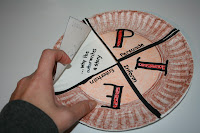I recently went to a school for a practicum, and was asked to do a lesson with the K-2 students (it was a multi-grade classroom setup). I prepared a Math lesson. I gave each student play dough (homemade play dough recipe coming soon!), and we practiced making numbers with it. For the K students, we just made numbers with the play dough. For the 1 and 2nd graders, we did addition facts where they had to make the answers using play dough. The second part of the lesson was writing ages on worksheets using star stickers. For K, I just had them put down their age in stars and then write their age below that. For 1st grade, they had to come up with [their age + what number = 10?]. For 2nd grade, the students had to make an addition fact that added up to their age. For example, one of my students is 8 years old. He made 4+4 using his stars.
I had extra stickers for the kids to decorate their pages. I think that was a really good idea. They loved having extra stickers.
Here is my lesson plan. It includes standards:
Math activity for grades K-2
Materials:
·
Math worksheet (provided)
·
Star Stickers
·
Other decorative stickers
·
Play dough
Kindergarten:
Guided practice: Making numbers with play dough—Make any
numbers between 1 and 10. The last number to make is the students’ age.
Independent practice: Placing age in stars on worksheet—The
students pick out the nu ber of stars equal to their age and place it on the
worksheet. They then write their age on the bottom line.
CCSS.Math.Content.K.CC.A.3
Write numbers from 0 to 20. Represent a number of objects with a written
numeral 0-20 (with 0 representing a count of no objects).
1st grade
Guided practice: Making addition fact answers with play
dough—have the students make the answers to addition facts such as 4+4, 8+8,
10+10, and other addition facts between 1 and 20.
Independent practice: Age + ? = 10 with stars—students place
their age in stars on the first line. They must then figure out how many more
stars they need to make 10, and place that number on the second line.
CCSS.Math.Content.1.OA.B.4
Understand subtraction as an unknown-addend problem. For example, subtract
10 - 8 by finding the number that makes 10 when added to 8.
2nd grade:
Guided practice: Making addition and subtraction facts with
play dough—addition within 20 such as 5+5, 8+9, 10-6, and others within 20.
Independent practice: ? + ? =age with stars.
 |
| Kindergarten Worksheet. I did this one, and that is why there are 10 stars. |
|
|
 |
| 1st grade worksheet |
 |
| 2nd Grade Worksheet |
 |
| Play Dough |
 |
| Play Dough 0 |
 |
| Play Dough 19 |
 |
| Kindergarten |
 |
| 1st Grade |
 |
| 2nd Grade |
 |
| Have some extra stickers for the kids to use to decorate their worksheets. They love the stickers! |
Questions? Did I not explain well enough? Comments are appreciated! Have a wonderful day and Happy teaching!


































